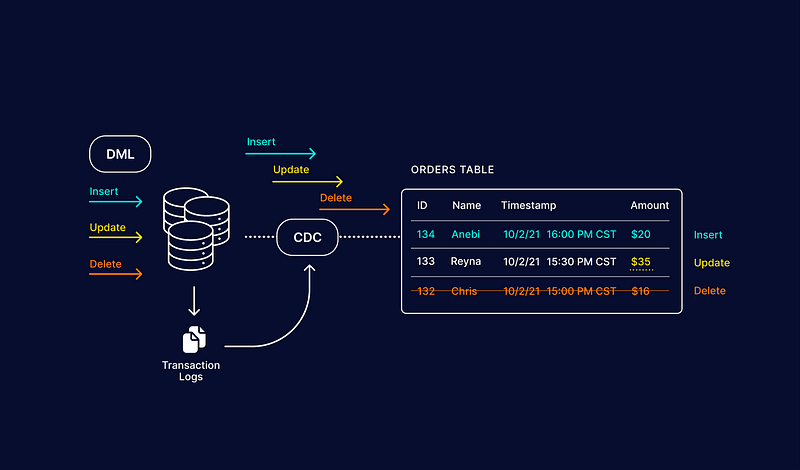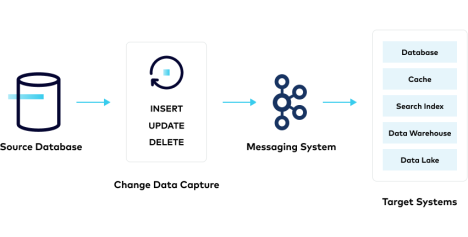The Change Data Capture (CDC) Design Pattern
Change Data Capture (CDC) is a design pattern that identifies and tracks changes in data so that action can be taken using this change…

Change Data Capture (CDC) is a design pattern that identifies and tracks changes in data so that action can be taken using this change data. It’s particularly crucial in data-driven architectures where it’s essential to promptly and reliably capture the modifications in the source data store and propagate them to downstream systems. CDC can be applied in various scenarios, including data replication, data warehousing, real-time analytics, and more.
How CDC Works
CDC works by monitoring and capturing changes in data at the source level, typically a database. These changes include inserts, updates, and deletes. Once a change is detected, CDC processes and forwards this change to a target system or application. This process can be synchronous or asynchronous, depending on the requirements of the system.
CDC Implementation Methods
There are several methods to implement CDC:
Trigger-Based: This method involves creating database triggers that fire on data changes. While this method is straightforward, it can impact database performance and is not suitable for high-volume environments.
Log-Based: This approach reads transaction logs of the database to identify changes. It’s more efficient than trigger-based CDC and has minimal impact on the source database performance.
Polling: In this method, the system periodically checks for changes in the database. It’s simple to implement but can be less efficient and timely compared to other methods.
Example Use Cases
Example 1: E-Commerce Platform
Consider an e-commerce platform that uses CDC to synchronize inventory data across its main transactional database and its analytics database.
Whenever a product’s quantity changes in the inventory (due to new stock coming in or a sale occurring), the CDC system detects this change. This could be implemented using log-based CDC, where the system reads the transaction logs of the database.
The change is then propagated in real-time to the analytics database, ensuring that the reporting and analytics systems always have the latest data. This real-time update allows the e-commerce platform to generate accurate, up-to-date reports on inventory levels, sales trends, and customer preferences.
Example 2: Banking System
In a banking system, CDC can be used to track changes in account balances and transactions.
For instance, when a customer makes a transaction, such as a deposit or withdrawal, the CDC system captures this change. This can be achieved using a combination of trigger-based and log-based CDC, ensuring both accuracy and efficiency.
The captured data can then be used for real-time fraud detection by analyzing unusual patterns or discrepancies in account activities.
Example 3: Customer Relationship Management (CRM) System
A CRM system often integrates data from various sources like sales, customer support, and marketing.
CDC can be employed to ensure that any updates in customer data across these systems are immediately reflected in the CRM. For example, if a customer’s contact information is updated in the sales database, the CDC system detects this change and updates the corresponding record in the CRM. This ensures that all departments have access to the most current customer information, leading to better customer service and more effective sales strategies.
Architectural Components

Source Databases: The starting point for any CDC implementation. It could be relational databases like MySQL, PostgreSQL, or NoSQL databases like MongoDB. The choice of CDC tool often depends on the source database’s compatibility and features.
CDC Engine: This is the core component responsible for capturing the data changes. Depending on the tool, this can be a log-based, trigger-based, or polling mechanism. The CDC engine processes the changes and prepares them for transfer to the target system.
Message Queue/Streaming Platform: A crucial component for handling and transporting the change data, especially in high-volume environments. Apache Kafka is a common choice, providing a scalable and reliable way to handle data streams.
Data Transformation Layer: In many cases, the captured data needs to be transformed or enriched before it is loaded into the target system. This layer can include simple format changes, complex transformations, or even data cleansing operations.
Target Systems: The destination for the captured changes. This could be a data warehouse (like Amazon Redshift or Snowflake), a data lake, another operational database, or even a real-time analytics system.
Monitoring and Management Tools: Essential for overseeing CDC operations. These tools monitor data flow, performance, error handling, and ensure data integrity. Examples include Prometheus for monitoring and Apache Airflow for workflow management.
CDC Tools
Database Native Tools: Many modern databases come with built-in CDC capabilities. Examples include Oracle GoldenGate, MySQL Binlog, and SQL Server Change Data Capture. These tools are tailored to their respective database systems and offer efficient log-based CDC mechanisms.
Open-Source CDC Tools: There are several open-source tools that offer CDC capabilities, such as Debezium and Apache NiFi. Debezium, for instance, is a distributed platform that captures row-level changes to databases using Kafka Connect.
Data Integration Platforms: Tools like Talend, Informatica, and IBM DataStage provide CDC functionalities as part of broader data integration solutions. These platforms can handle complex data transformations and integrations, making them suitable for enterprise-level CDC implementations.
Streaming Platforms: Apache Kafka, often used in conjunction with other CDC tools like Debezium, is crucial for handling streaming data. It provides a distributed system for collecting, storing, and processing real-time data streams, making it an excellent platform for CDC use cases that require high throughput and low latency.
Cloud-based CDC Services: Cloud providers like AWS, Azure, and Google Cloud offer CDC services. AWS DMS (Database Migration Service) and Azure Data Factory, for example, provide capabilities for capturing and replicating data changes.
Best Practices in CDC Architecture
- Scalability and Performance: Design the architecture to handle current and future data volumes without significant performance degradation.
- Fault Tolerance and Reliability: Implement mechanisms to handle failures gracefully, ensuring data consistency and minimal downtime.
- Security: Secure the data in transit and at rest, especially when dealing with sensitive information.
- Flexibility: Choose tools and components that can adapt to different data sources and target systems, ensuring longevity and adaptability of the CDC solution.
- Data Quality: Implement checks and balances to ensure the accuracy and integrity of the captured data.
- Real-time Processing: If real-time data synchronization is a requirement, prioritize tools and architectural designs that minimize latency.
🚀 Explore a Wealth of Resources in Software Development and More by Luis Soares
📚 Learning Hub: Expand your knowledge in various tech domains, including Rust, Software Development, Cloud Computing, Cyber Security, Blockchain, and Linux, through my extensive resource collection:
- Hands-On Tutorials with GitHub Repos: Gain practical skills across different technologies with step-by-step tutorials, complemented by dedicated GitHub repositories. Access Tutorials
- In-Depth Guides & Articles: Deep dive into core concepts of Rust, Software Development, Cloud Computing, and more, with detailed guides and articles filled with practical examples. Read More
- E-Books Collection: Enhance your understanding of various tech fields with a series of free e-Books, including titles like “Mastering Rust Ownership” and “Application Security Guide” Download eBook
- Project Showcases: Discover a range of fully functional projects across different domains, such as an API Gateway, Blockchain Network, Cyber Security Tools, Cloud Services, and more. View Projects
- LinkedIn Newsletter: Stay ahead in the fast-evolving tech landscape with regular updates and insights on Rust, Software Development, and emerging technologies by subscribing to my newsletter on LinkedIn. Subscribe Here
🔗 Connect with Me:
- Medium: Read my articles on Medium and give claps if you find them helpful. It motivates me to keep writing and sharing Rust content. Follow on Medium
- Personal Blog: Discover more on my personal blog, a hub for all my Rust-related content. Visit Blog
- LinkedIn: Join my professional network for more insightful discussions and updates. Connect on LinkedIn
- Twitter: Follow me on Twitter for quick updates and thoughts on Rust programming. Follow on Twitter
Wanna talk? Leave a comment or drop me a message!
All the best,
Luis Soares
luis.soares@linux.com
Senior Software Engineer | Cloud Engineer | SRE | Tech Lead | Rust | Golang | Java | ML AI & Statistics | Web3 & Blockchain



